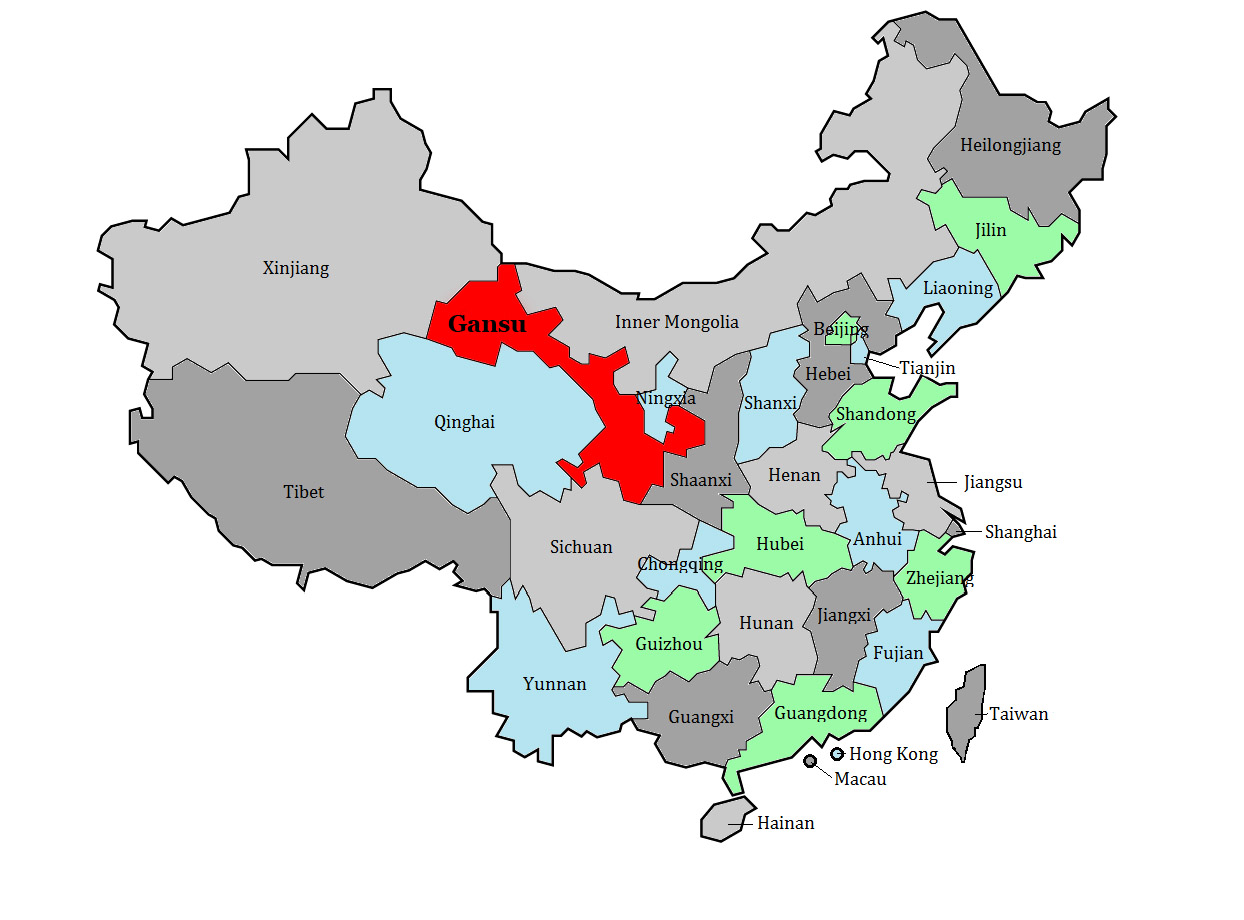Gansu Province
Background
Located in the north-west of China, between the Tibetan and Huangtu plateaus, Gansu connects the Chinese heartland with the vast desert region to the northwest. Covering a total area of around 450,000 km2, roughly the size of Sweden, Gansu borders 6 different Chinese provinces or autonomous regions: Inner Mongolia, Ningxia, Xinjiang, Qinghai, Sichuan, and Shaanxi, as well as having a border with Mongolia.
Archaeological findings have shown that Gansu has been inhabited since at least 6000 BCE. Later, China’s founding Qin Dynasty had its roots in the area. As the Chinese empire expanded during the Han Dynasty, so too followed China’s Great Wall and, much later, the province’s first railway through Gansu’s Hexi Corridor. The Hexi Corridor is an east-west route which runs through the heart of the province, and connects China to Central Asia and the West. The Hexi Corridor eventually became a key leg of the Silk Road, an important trade route that made Gansu important not only as a center of economic trade, but as a place of cultural and religious exchange. As the silk trade grew, so did the trading posts along the Hexi corridor. Many of these ancient posts form the major population centers of Gansu today. The blending of cultures in Gansu eventually led to ethnic tensions such as the 1862-1877 Muslim rebellions left millions dead. Gansu is highly seismically active. A 1920 8.5 magnitude earthquake, for instance, killed over 200,000 people.
People
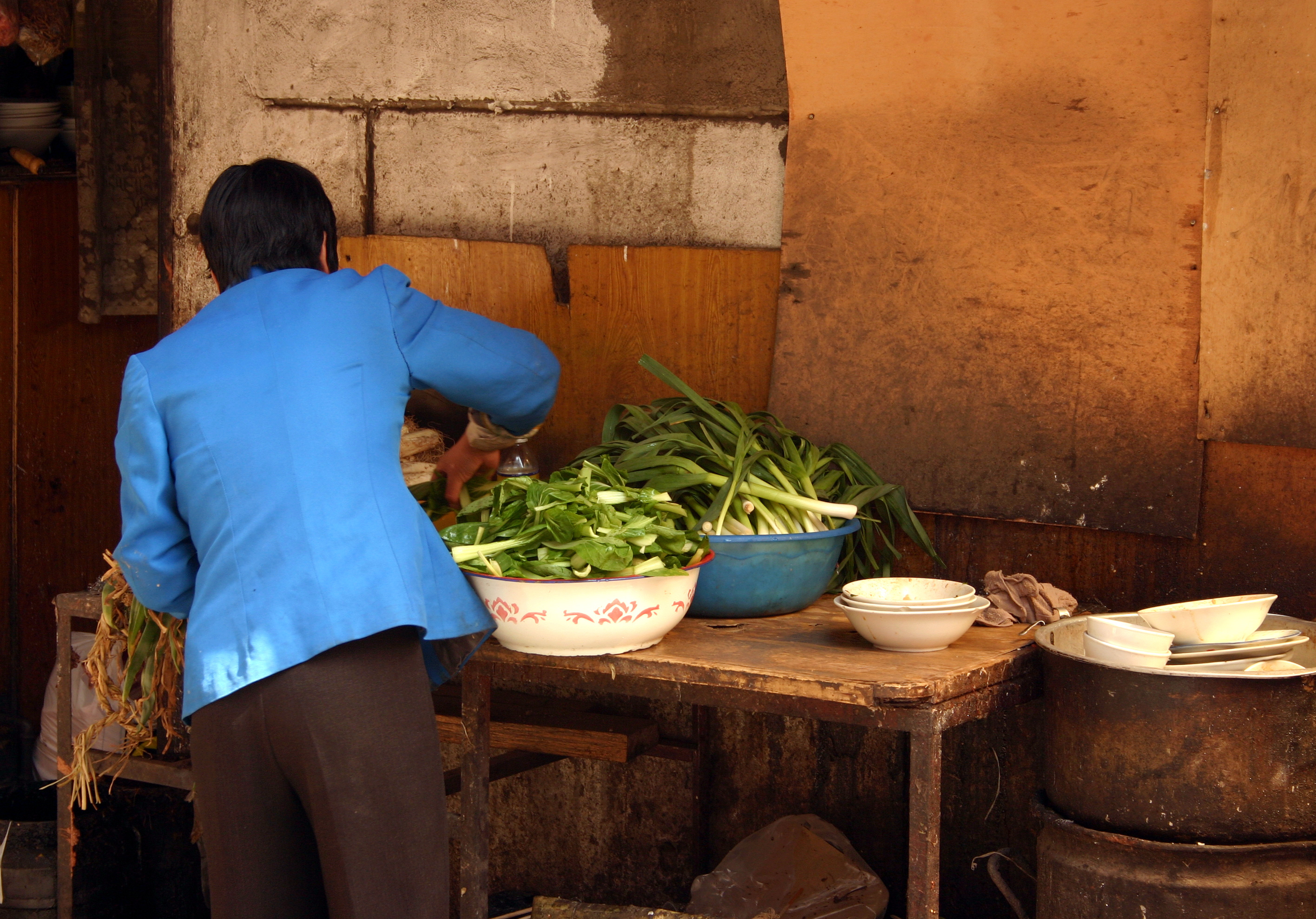
Preparing Shop Food, Lanzhou
In 2018, Gansu has a population of roughly 26 million people. Its population accounts for approximately 2% of China’s total, and it is the 22nd most populous province out of China’s 33 provinces, municipalities, and autonomous regions. Almost 92% of the population is Han Chinese with the rest being made up of Hui, Tibetan, Dongxiang, Tu, Manchu, Uyghur, Yugur, Bonan, Mongolian, Salar, and Kazakh minorities. This rich mix of people means that the province abounds with mosques, monasteries and temples.
Economy
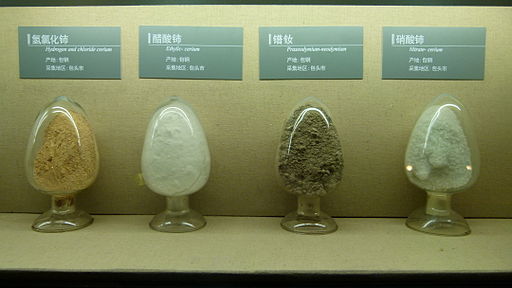
Rare Earths Display
According to China’s National Bureau of Statistics, in 2018 Gansu’s GDP was approximately $114 billion, the 28th out of 33 largest in the country. Its GDP per capita approximately $4,303. Overall, its GDP accounts for .9% of China’s total which was generated by 1.9% of China’s population. Its GDP per capita is ranked 33rd out of China’s 33 provinces, municipalities, and autonomous regions.

Gansu Desert Lake
Gansu’s primary industries accounted for approximately 12% of GDP in 2017. Important agricultural crops include corn, wheat, tubers, cotton, linseed oil, maize, melons, millet, wheat, sugar beets, rapeseed, soybeans, a variety of fruits and vegetables, and a vast array of Chinese medicinal herbs. Gansu also has a significant animal husbandry sector which raises cattle, horses, donkeys, sheep, two-humped camels, and goats. Historically, Gansu struggled to produce enough grain to feed itself. Increased irrigation, the collection and storage of rain runoff, mechanization, usage of chemical fertilizer, and mulching with plastic film have materially improved agricultural yields.
Gansu also has significant deposits of over 145 different minerals, including many rare earth elements. Other significant deposits include potassium, cobalt, chromite, stibium, barite, baudisserite, selenium, gold, iridium, chromium, coal, iron, lead, crude oil, platinum, tungsten, lithium, and zinc as well as massive deposits of nickel. Over 90% of China’s nickel deposits can be found in Gansu. The province also significant reserves of petroleum, coal and natural gas.

Great Wall and Fort, Jiayugen
Gansu’s secondary industries accounted for approximately 34% of GDP in 2017. Modern industrial development in Gansu did not begin until after the railroad through the Hexi Corridor was completed in the mid-1950s. It was Mao Zedong‘s idea to transform the province into a center of heavy industry with Lanzhou, the capital, at its heart. Mao believed that by dispersing China’s manufacturing bases in western China, China would better be able to defend them in the case of enemy attack. Gansu today engages in mining, electricity generation, nuclear power, petrochemical extraction and refining, metallurgy, oil exploration machinery, building material production, locomotive equipment, chemical fertilizers, petrochemicals, hydropower and other renewable energy manufacturing including solar and wind. Gansu is one of the most important solar energy bases in China and ranks fifth in terms of wind energy generation. Gansu also has some forest reserves. To take advantage of its animal husbandry and agricultural sectors, the province is also investing in leather and food processing.
Gansu’s tertiary industries accounted for 54.1% of its GDP in 2017. In terms of leading tertiary industries, the province’s wholesale and retail trade and its financial intermediation sector each accounted for approximately 14% of the tertiary sector output.
In 2017, Gansu’s foreign direct investment was approximately $43 million down from $135 million in 2010. Hong Kong the largest investor in the province followed by Germany, the US and France.
Lay of the Land

Danxia Landform
Gansu is in China’s north western region. The province contains the geographical center of China. It resides on the upper reaches of the Yellow River in China’s western inland area, between the Tibetan Plateau, Inner Mongolia Autonomous Region and the Loess Plateau. Because Gansu is located at the intersection of three Highlands: the Qinghai-Tibet Plateau, the Inner Mongolia plateau and the Huangtu or Loess Plateau, it is an elevated area, with an average elevation of over 1000m above sea level. Part of the Qinlin Mountain range extends through the province’s south, making the southern region very rugged while the north is flat. The Yellow River not only flows through the south of Gansu, but it gets much water from sources within the province. The river has allowed Gansu to be settled since pre-historic times. Away from the Yellow River and its various oases that dot the Hexi Corridor, Gansu is an arid, barren land with warm to hot summers, and very cold winters. In some areas, Gansu becomes subarctic, with temperatures dropping to -40 degrees Celsius during the winter.
A natural land passage known as the Hexi Corridor runs through the center of the province. The Hexi Corridor extends 1200 km passage from Lanzhou to the Jade Gate and is peppered with oases. The Hexi Corridor is bound in the south by the snow-capped Qilian Mountains, with the highest peak in the province reaching 5547m above sea level, and in the north by the flat grasslands of Mongolia and the Gobi Desert.
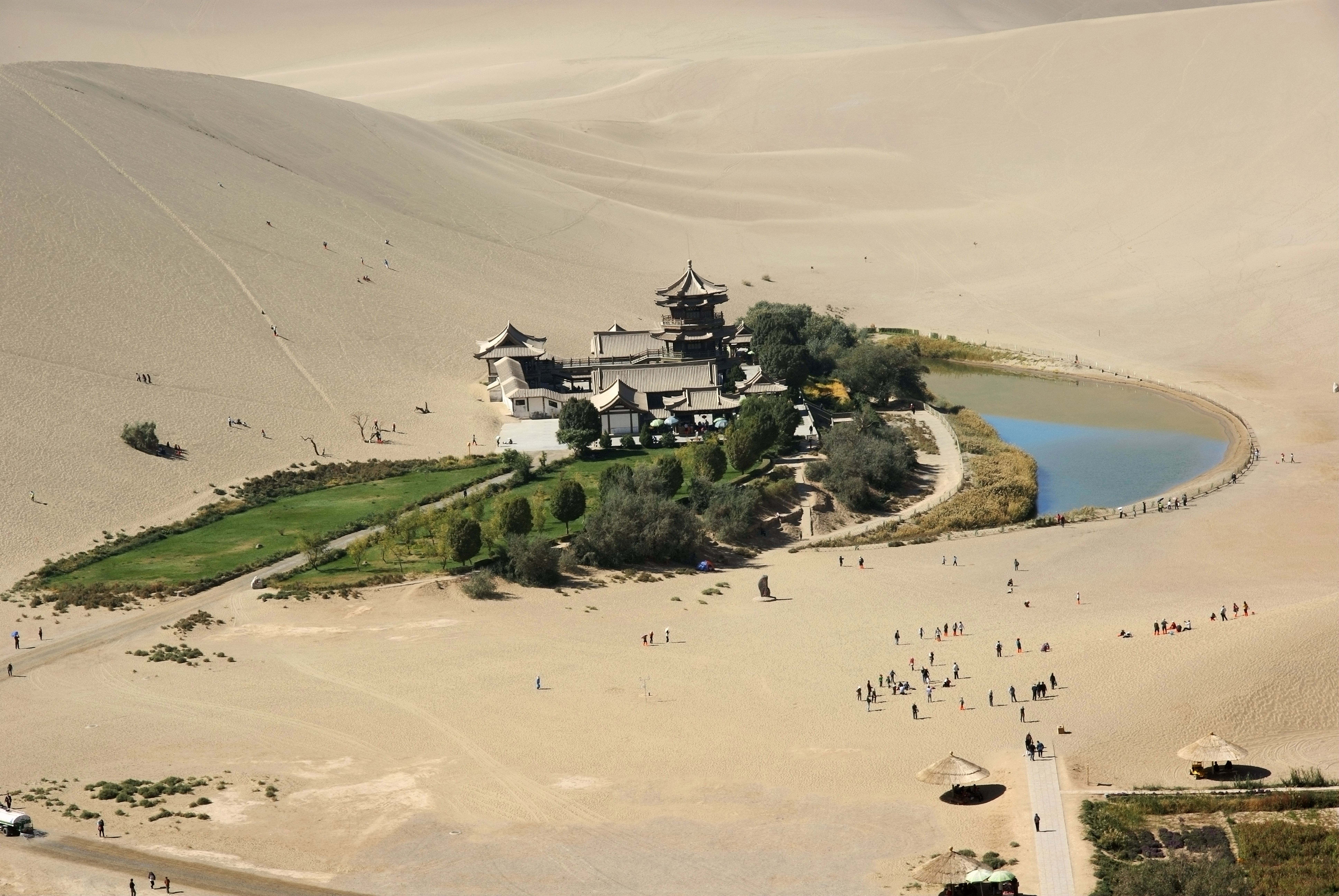
Crescent Moon Lake Oasis
Desertification is a serious issue throughout the province. Gansu sees little rain and can be plagued by dust storms in the spring. China is currently working in conjunction with the Asian Development Bank on what has been called the Silk Road Ecosystem Restoration Project whose aim is to reverse desertification in the province.
Earthquakes are another challenge for the area. Gansu experiences tectonic activity caused by the movements along the Eurasian and Indian Plates. The eastern part of Gansu has been hit by major earthquakes which have taken place on average every 65 years since the 6th century, while minor earthquakes shake the province approximately once every 10 years.
Interesting Aspects for a Traveler

Grotto Ruins, Mati Temple, Zhangye
Lanzhou, the province’s capital, is located at the cartographic heart of China and hosts the Gansu Provincial Museum. However, Dunhuang, a small oasis town that prospered during the Silk Road, is the main reason that most people visit Gansu. Surrounding it are forts, towers and cave temples as well as magnificent sand dunes. The Dunhuang cave paintings are some of the best Buddhist paintings in China. A half hour drive from Dunhuang are the Mogao caves which also hold some of the best Buddhist paintings in China, if not in the world, and are a UNESCO World Heritage site.
Buddhism arrived in China over the Silk Road, and the sculptures at Bingling Si were one of the first Buddhist monuments to be created in China. Known as the Thousand Buddha Caves, they were carved over a period of 1,600 years by sculptors hanging from ropes. They were funded by wealthy Silk Road traders heading west. Isolated by the waters of the Yellow River – which saved them from destruction during the Cultural Revolution –reaching them requires boat travel.
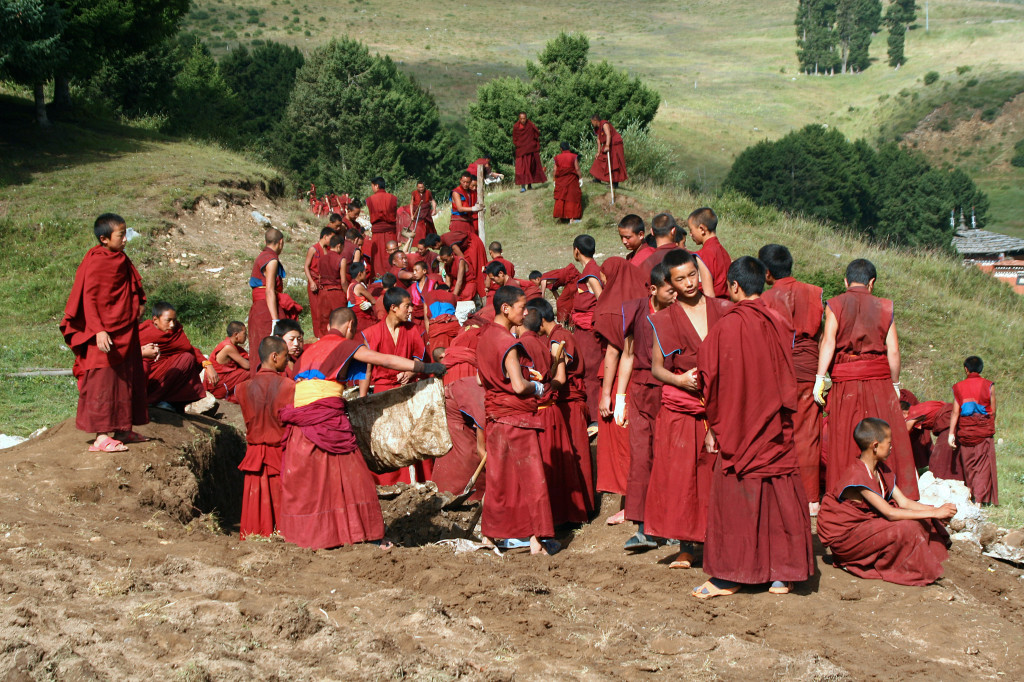
Monks Repair Water System, Labrang Monastery
Xiahe is an important Tibetan Monastery town that still sees Buddhist pilgrims flock to its beautiful, spiritual Labrang Monastery founded in 1709. The monastery is one of the six major Tibetan monasteries of the Yellow Hat Sect of Tibetan Buddhism.
Langmusi is a remote mountain town set in beautiful country. It boasts beautiful walking trails that are dotted with several Buddhist temples.
Jiayuguan was considered China’s final outpost before the desert, and still houses the ancient Jiayuguan Fort and the Great Wall Museum which tells the story of the Wall from the Han to Ming Dynasties.
Singing Sand Mountain and Crescent Moon Lake also attract many visitors due to their breath-taking scenery.

